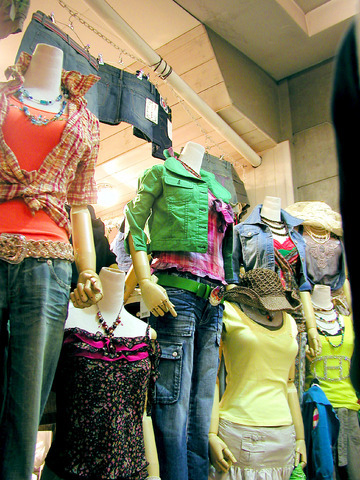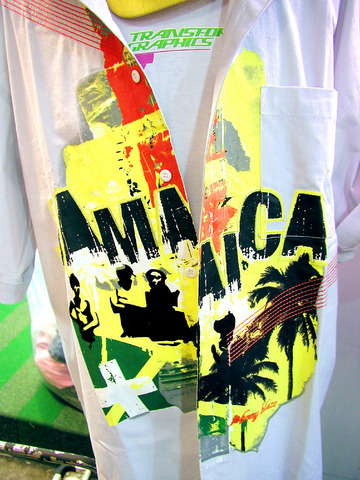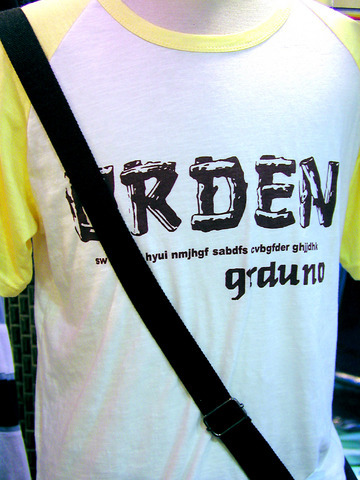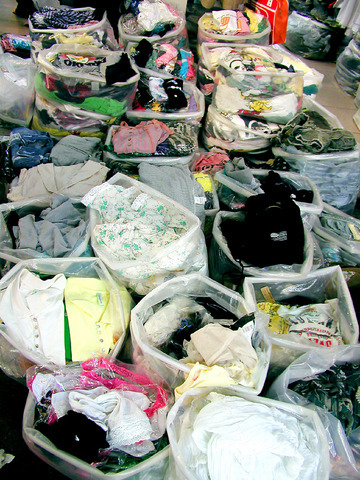The Wufenpu Garment Wholesale Area, as the popular clothing market opposite Taipei's Songshan train station is called, is a place that solves many of Taiwan's fashion mysteries in one fell swoop.
It's here in this semi-open-air market -- semi, because the goods spill out of the stores and onto the sidewalks and into the alleys -- where over 100 outlets supply a significant portion of the wardrobes favored by Taiwanese of all ages and fashion persuasions. And they do a brisk trade, with some stores selling by weight instead of item count, though single purchases of items are usually welcome.
Stores tend to specialize in specific fashion niches, such as trendy teeny-bopper gear, extra-large sizes, pet fashions, qipaos and pseudo-ethnic wear. Whatever their different specialties, they share a price range at the lowest end of the scale for clothes in Taipei.

PHOTO: MAX WOODWORTH, TAIPEI TIMES
"It's a race here to the bottom, price-wise," said one storeowner surnamed Chen (
Which is perhaps why Wufenpu has become a term that, when evoked in description of someone's fashion-sense, is intended to carry the sting of an accusation of poor taste and quality.
Popular actress Hsiao Shu-shen (

But despite the sneering aimed at the supposedly chintzy goods flooding out of Wufenpu, many people wandering the smart areas of Taipei are actually decked out in Wufenpu clothes and are making a fairly convincing show of having paid top dollar for their faux retro Mickey Mouse T-shirt or their sexy velour halter top. (Then again, some may have actually paid top dollar in East District boutiques for the clothes, but they would be suckers.)
It turns out that a lot of East District yuppies and hipsters, as well as teenagers mimicking pop star Jolin Tsai's (
But don't be fooled. The T-shirt with a Mary icon print and the words "Mary is my home girl" can be found at the market for about NT$200.

So before dropping a wad of cash for a DJ Guevara T-shirt or for an allegedly Nepalese skirt in front of the Dunhua South Road Eslite bookstore, savvy shoppers will make the trek to Wufenpu to pick them up for about NT$200 each.
Wufenpu is at its busiest on Mondays, as vendors from all parts of Taiwan come to stock up on goods that are later sold at night markets and stores. Using rapidly flashed hand signals, vendors haggle over prices for enormous bundles of clothes, which are then transported out of the narrow alleys behind scooters specially rigged with carts to the train station or to waiting courier trucks. From there, the clothes fan out around the city and the rest of Taiwan.
How the clothes reach Wufenpu, however, is a matter of considerable debate. The typical claim from vendors at the market for the provenance of their clothes is that they come from Hong Kong, Thailand and Japan. One vendor, however, confided that most of the products, in fact, were made in Taiwan.

Either way, the sheer volume of knock-off goods provides ample reason to question how forthright the stores are about their products. But judging from the number of customers, no one seems to dwell on the point.
The market fulfills a huge range of fashion demands for all ages and that's good enough for most. And with its low prices, the market guarantees that the winds of fashion can change quickly without leaving everyone in the dust.

Most heroes are remembered for the battles they fought. Taiwan’s Black Bat Squadron is remembered for flying into Chinese airspace 838 times between 1953 and 1967, and for the 148 men whose sacrifice bought the intelligence that kept Taiwan secure. Two-thirds of the squadron died carrying out missions most people wouldn’t learn about for another 40 years. The squadron lost 15 aircraft and 148 crew members over those 14 years, making it the deadliest unit in Taiwan’s military history by casualty rate. They flew at night, often at low altitudes, straight into some of the most heavily defended airspace in Asia.

Beijing’s ironic, abusive tantrums aimed at Japan since Japanese Prime Minister Sanae Takaichi publicly stated that a Taiwan contingency would be an existential crisis for Japan, have revealed for all the world to see that the People’s Republic of China (PRC) lusts after Okinawa. We all owe Takaichi a debt of thanks for getting the PRC to make that public. The PRC and its netizens, taking their cue from the Chinese Communist Party (CCP), are presenting Okinawa by mirroring the claims about Taiwan. Official PRC propaganda organs began to wax lyrical about Okinawa’s “unsettled status” beginning last month. A Global

Taiwan’s democracy is at risk. Be very alarmed. This is not a drill. The current constitutional crisis progressed slowly, then suddenly. Political tensions, partisan hostility and emotions are all running high right when cool heads and calm negotiation are most needed. Oxford defines brinkmanship as: “The art or practice of pursuing a dangerous policy to the limits of safety before stopping, especially in politics.” It says the term comes from a quote from a 1956 Cold War interview with then-American Secretary of State John Foster Dulles, when he said: ‘The ability to get to the verge without getting into the war is

Like much in the world today, theater has experienced major disruptions over the six years since COVID-19. The pandemic, the war in Ukraine and social media have created a new normal of geopolitical and information uncertainty, and the performing arts are not immune to these effects. “Ten years ago people wanted to come to the theater to engage with important issues, but now the Internet allows them to engage with those issues powerfully and immediately,” said Faith Tan, programming director of the Esplanade in Singapore, speaking last week in Japan. “One reaction to unpredictability has been a renewed emphasis on